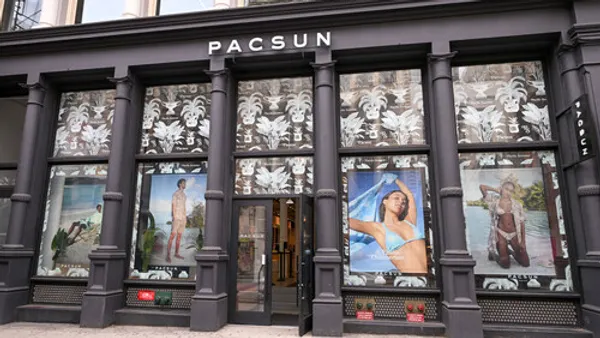The U.S. consumer may be slowing down, but Walmart is not.
The retail giant is notching market share gains by leveraging its massive legacy brick-and-mortar footprint as well as embracing new revenue streams, according to recent research from analysts at various firms. In the process, Walmart is treading on territory previously staked out by Target, Amazon and others.
“In the medium term, Walmart continues to expand its vision beyond retail and e-commerce, with a focus on building a powerful ecosystem globally, including advertising, merchant services, last-mile delivery, health services, and digital payments,” Telsey Advisory Group analysts led by Joseph Feldman said in an August report. “These new elements of the ecosystem are more profitable than traditional retail and collectively should help strengthen Walmart's relationship with customers and generate profitable market share.”
Walmart follows Target with sweeping plans to revamp its locations. Walmart executives told Telsey that its remodeled stores have brought “a double-digit sales lift” to those locations and that the retailer is on track to remodel about 300 U.S. Walmart stores this year. The company is taking another page from Target’s playbook with plans to expand the employment of its store network to fulfill online orders, which executives called “significantly cheaper than shipping from a warehouse.” Half of Walmart’s Q2 e-commerce orders were fulfilled by stores, per Telsey’s note.
Walmart appears to be attracting the higher-income customers that often prefer Target, and expanding the marketplace model innovated by Amazon.
Name brands like Dyson, Whirlpool and Solo Stove have signed on to the Walmart marketplace, which now offers some 400 million items, UBS analysts led by Michael Lasser said in a Thursday research note. More name-brand items are on their way, in order to appeal to higher-income customers, per that report.
Walmart “is unified, fortified and energized,” Lasser said. “The bullish investment case for the world’s largest retailer is as good as it's been in a while.”
Moreover, in another area perfected by Amazon, the company is tapping and expanding “several revenue sources like advertising, marketplace fees, fulfillment services and logistics that are going to grow 20-30% and have 40-80% margins,” UBS said. Several analysts also noted Walmart’s long-term automation plans, which promise to help boost efficiencies.
Walmart’s assertiveness comes at a time when consumers have been battered by higher prices, which have hurt retailers that depend more on sales of discretionary goods, especially specialty retailers and department stores. That also includes Target, a mass merchant whose approach borrows heavily from old-school department store merchandising.
Wells Fargo analysts led by Edward Kelly, describing discussions with various retail executives in a Thursday report, said that the “consumer remains on a steadily slowing glide path, but no one sounded the alarm bell.”
Among those participating, concerns included weaker demand in soft goods like apparel, “especially with higher gas prices and student loans as incoming headwinds,” Kelly said. Target “sounded the most cautious (likely given its momentum and high discretionary mix),” while Walmart signaled the most optimism, “likely a function of its share gain.”
Walmart is expecting that the price cuts it wrung from vendors amid peak inflation could continue even as inflation eases, analysts from more than one firm said. As UBS noted, while Walmart “probably won’t carry high-end luxury goods,” it is wooing higher-end consumers. Plus, as Wells Fargo said, the retailer also appears to be winning over customers who shop at the likes of Dollar Tree.
In short, “a more combative [Walmart] isn't good for competitors,” Wells Fargo’s Kelly said.















